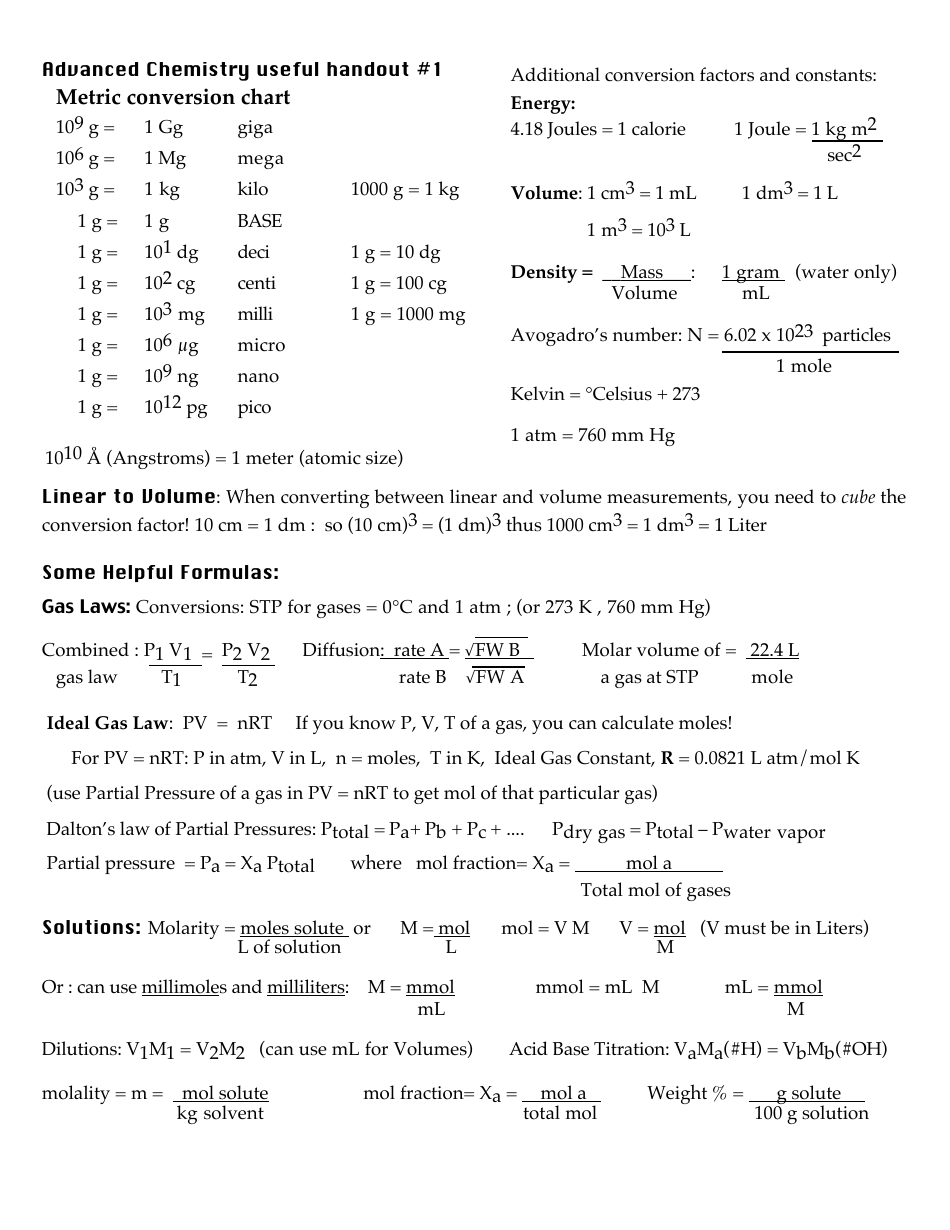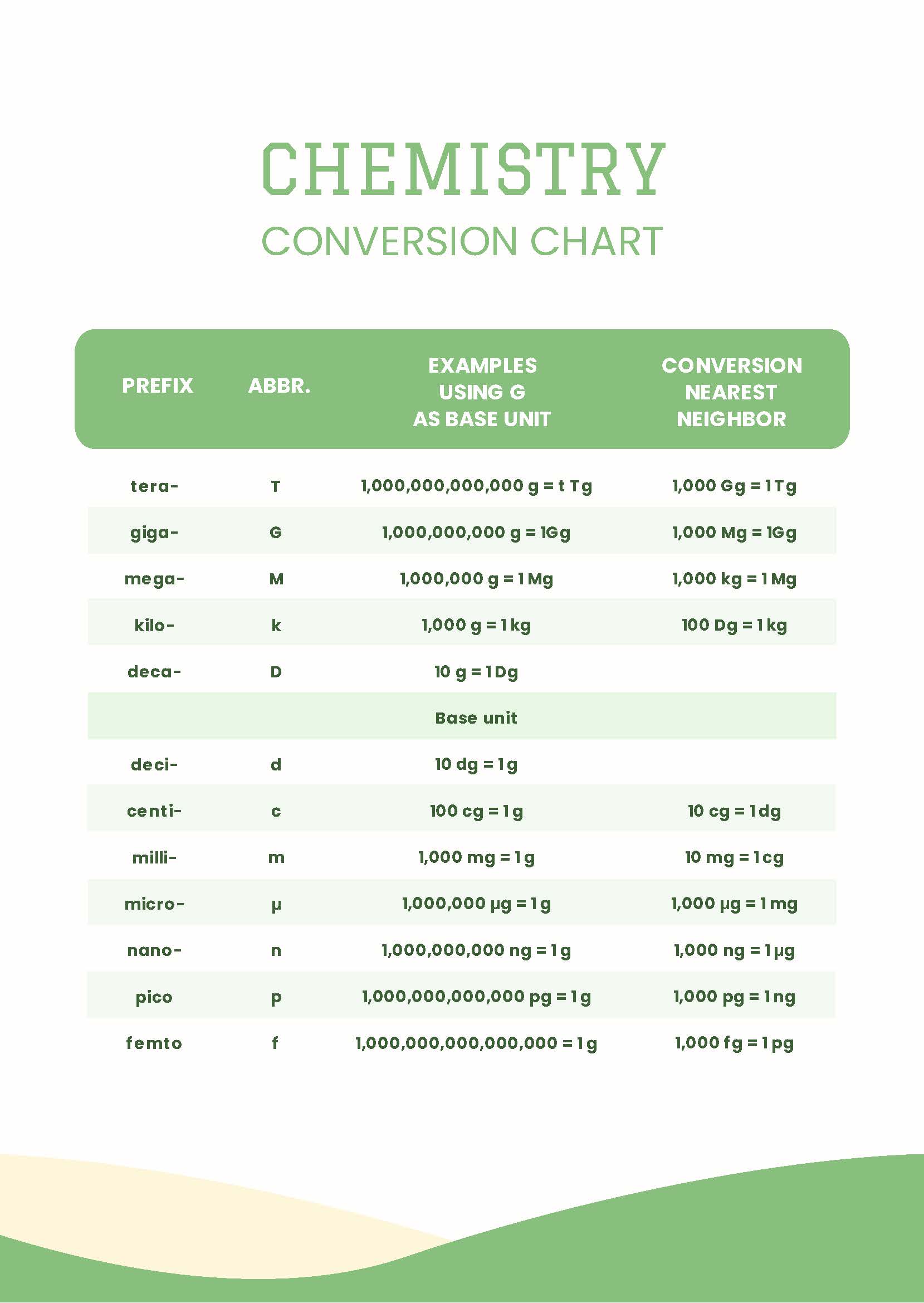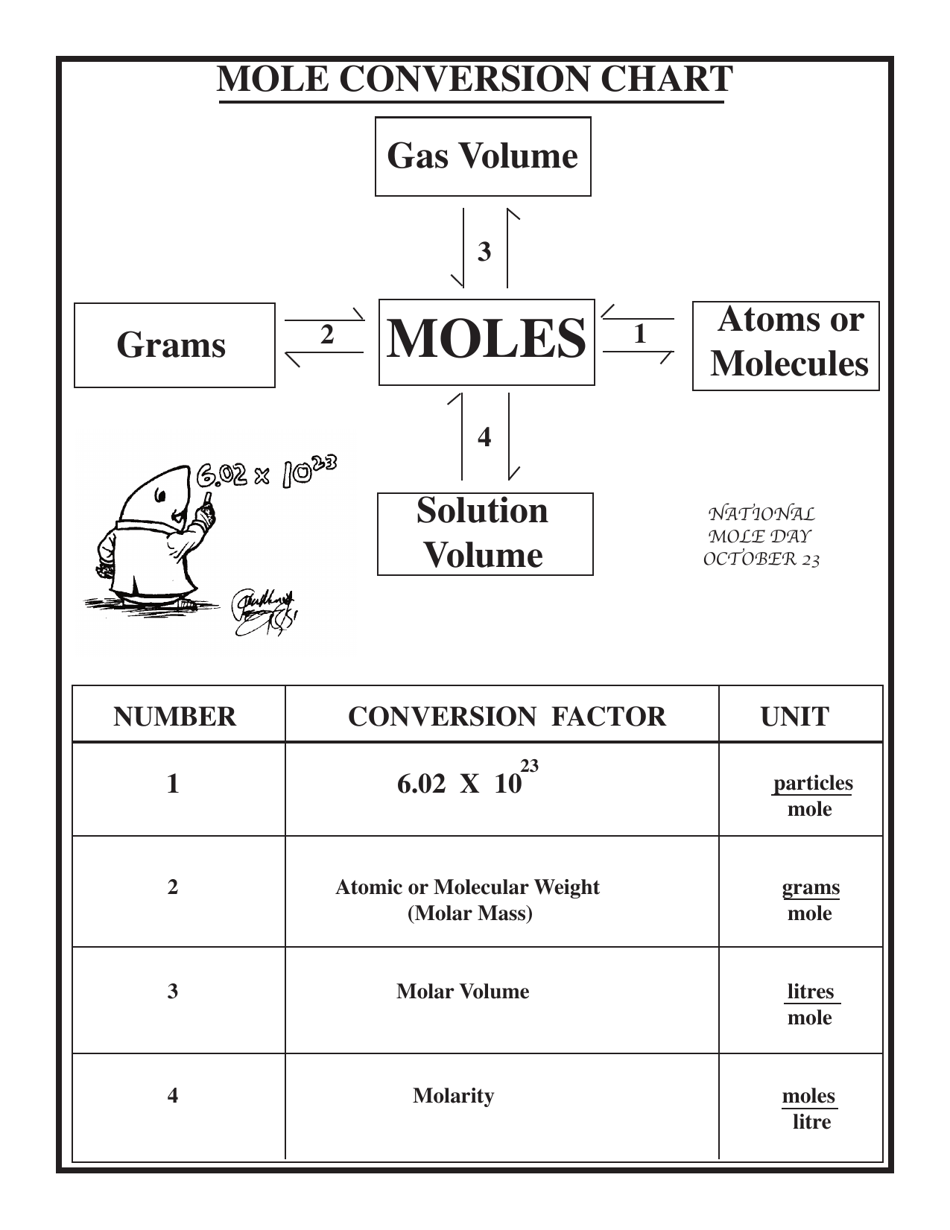Conversion Sheet Chemistry - 1 min = 60 sec 1 hour = 60 min = 3600 sec 1 day = 24 hours = 86400 sec 1 week = 7 days 1 year = 52 weeks = 12 months = 365 days 100 years = 1 century. Other conversions energy pressure 1 cal =. Liter o the basic unit of. Conversion factor sheet time : Common chemistry conversions english to metric conversions (mass, length, volume, and area conversions are good to 4 significant figures). Meter o the basic unit of volume is: Start with what you know and let the conversion factor units decide how to set up the problem. Conversion tables all quantities (mass, length, density, speed, force, pressure, energy, power) listed in these conversion tables can be ultimately expressed in the following three basic units: If a unit to be converted is in the numerator, that unit must be in the denominator. Basic conversion cheat sheet •three basic units of measurement length, mass (weight), volume o the basic unit of length is:
Meter o the basic unit of volume is: Conversion factor sheet time : Other conversions energy pressure 1 cal =. 1 min = 60 sec 1 hour = 60 min = 3600 sec 1 day = 24 hours = 86400 sec 1 week = 7 days 1 year = 52 weeks = 12 months = 365 days 100 years = 1 century. Start with what you know and let the conversion factor units decide how to set up the problem. Conversion tables all quantities (mass, length, density, speed, force, pressure, energy, power) listed in these conversion tables can be ultimately expressed in the following three basic units: Common chemistry conversions english to metric conversions (mass, length, volume, and area conversions are good to 4 significant figures). If a unit to be converted is in the numerator, that unit must be in the denominator. Basic conversion cheat sheet •three basic units of measurement length, mass (weight), volume o the basic unit of length is: Liter o the basic unit of.
Liter o the basic unit of. Meter o the basic unit of volume is: Start with what you know and let the conversion factor units decide how to set up the problem. 1 min = 60 sec 1 hour = 60 min = 3600 sec 1 day = 24 hours = 86400 sec 1 week = 7 days 1 year = 52 weeks = 12 months = 365 days 100 years = 1 century. Conversion tables all quantities (mass, length, density, speed, force, pressure, energy, power) listed in these conversion tables can be ultimately expressed in the following three basic units: Common chemistry conversions english to metric conversions (mass, length, volume, and area conversions are good to 4 significant figures). If a unit to be converted is in the numerator, that unit must be in the denominator. Basic conversion cheat sheet •three basic units of measurement length, mass (weight), volume o the basic unit of length is: Other conversions energy pressure 1 cal =. Conversion factor sheet time :
Conversion Reference Sheet
Common chemistry conversions english to metric conversions (mass, length, volume, and area conversions are good to 4 significant figures). Start with what you know and let the conversion factor units decide how to set up the problem. 1 min = 60 sec 1 hour = 60 min = 3600 sec 1 day = 24 hours = 86400 sec 1 week.
Chemistry Conversion Chart Cheat Sheet
Common chemistry conversions english to metric conversions (mass, length, volume, and area conversions are good to 4 significant figures). Start with what you know and let the conversion factor units decide how to set up the problem. Basic conversion cheat sheet •three basic units of measurement length, mass (weight), volume o the basic unit of length is: Liter o the.
Conversion Sheet For Chemistry
Conversion factor sheet time : Conversion tables all quantities (mass, length, density, speed, force, pressure, energy, power) listed in these conversion tables can be ultimately expressed in the following three basic units: If a unit to be converted is in the numerator, that unit must be in the denominator. Other conversions energy pressure 1 cal =. Basic conversion cheat sheet.
Unit Conversion Worksheets Chemistry
1 min = 60 sec 1 hour = 60 min = 3600 sec 1 day = 24 hours = 86400 sec 1 week = 7 days 1 year = 52 weeks = 12 months = 365 days 100 years = 1 century. Common chemistry conversions english to metric conversions (mass, length, volume, and area conversions are good to 4 significant.
Conversion Chart For Chemistry Measurements
Other conversions energy pressure 1 cal =. Basic conversion cheat sheet •three basic units of measurement length, mass (weight), volume o the basic unit of length is: 1 min = 60 sec 1 hour = 60 min = 3600 sec 1 day = 24 hours = 86400 sec 1 week = 7 days 1 year = 52 weeks = 12.
Chemistry Unit Conversion Sheet
Basic conversion cheat sheet •three basic units of measurement length, mass (weight), volume o the basic unit of length is: Conversion tables all quantities (mass, length, density, speed, force, pressure, energy, power) listed in these conversion tables can be ultimately expressed in the following three basic units: Other conversions energy pressure 1 cal =. 1 min = 60 sec 1.
Conversion Factors how to convert between units using conversion
Conversion factor sheet time : Basic conversion cheat sheet •three basic units of measurement length, mass (weight), volume o the basic unit of length is: Liter o the basic unit of. Common chemistry conversions english to metric conversions (mass, length, volume, and area conversions are good to 4 significant figures). Meter o the basic unit of volume is:
Cheat Sheet Chemistry Conversion Chart Gram Conversion Chart
1 min = 60 sec 1 hour = 60 min = 3600 sec 1 day = 24 hours = 86400 sec 1 week = 7 days 1 year = 52 weeks = 12 months = 365 days 100 years = 1 century. Conversion factor sheet time : Start with what you know and let the conversion factor units decide how.
Significant Figures Worksheet Chemistry Answers
Basic conversion cheat sheet •three basic units of measurement length, mass (weight), volume o the basic unit of length is: Conversion factor sheet time : Meter o the basic unit of volume is: If a unit to be converted is in the numerator, that unit must be in the denominator. Start with what you know and let the conversion factor.
Chemistry Cheat Sheet Mole Conversion Chart Download Printable PDF
1 min = 60 sec 1 hour = 60 min = 3600 sec 1 day = 24 hours = 86400 sec 1 week = 7 days 1 year = 52 weeks = 12 months = 365 days 100 years = 1 century. Liter o the basic unit of. Common chemistry conversions english to metric conversions (mass, length, volume, and area.
Conversion Factor Sheet Time :
Meter o the basic unit of volume is: Liter o the basic unit of. 1 min = 60 sec 1 hour = 60 min = 3600 sec 1 day = 24 hours = 86400 sec 1 week = 7 days 1 year = 52 weeks = 12 months = 365 days 100 years = 1 century. Basic conversion cheat sheet •three basic units of measurement length, mass (weight), volume o the basic unit of length is:
Common Chemistry Conversions English To Metric Conversions (Mass, Length, Volume, And Area Conversions Are Good To 4 Significant Figures).
Other conversions energy pressure 1 cal =. Conversion tables all quantities (mass, length, density, speed, force, pressure, energy, power) listed in these conversion tables can be ultimately expressed in the following three basic units: If a unit to be converted is in the numerator, that unit must be in the denominator. Start with what you know and let the conversion factor units decide how to set up the problem.









